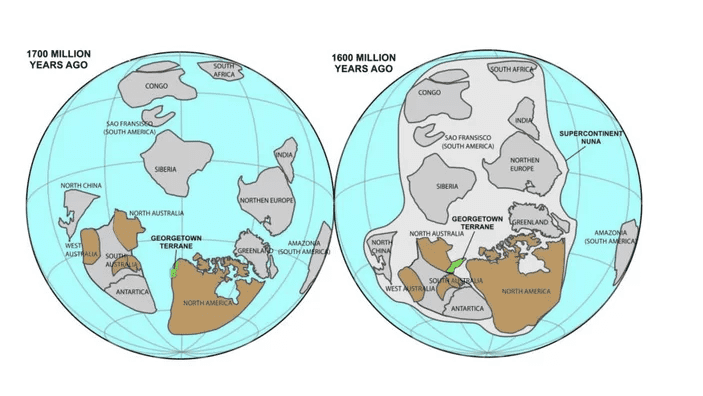Geologists analyzed rocks collected from opposite sides of the world and concluded that they match. The conclusion: a part of Australia was once attached to North America about 1.7 billion years ago.

Georgetown area while still attached to North America (left). About 100 million years later, Georgetown joined the North Australia landmass. Credit: Journal Geology.
Australian scientists from Curtin University examined sandstone sedimentary rocks which formed in a shallow sea, collected from the Georgetown region in northern Queensland. From the get-go, these samples were peculiar — they didn’t resemble any other rocks found in Australia. Instead, they matched rocks found in present-day Canada, as reported in the journal Geology.
After much deliberation, the scientists hypothesize that Georgetown broke away from North America 1.7 billion years ago. After more slow, but steady, tectonic movement, Georgetown collided with what is now northern Australia, at Mount Isa, some 100 million years later.
Perhaps this sort of news sounds peculiar, but for geologists, this is anything but. Through Earth’s history spanning more than four billion years, landmasses have come together and drifted apart countless times and in various configurations, driven by the caprices of tectonic motion. For instance, some 300 million years ago, all of the continents came together to form one single supercontinent known as Pangaea.
Pangaea likely wasn’t the only supercontinent in the planet’s geological history. Although scientists are still piecing together the jigsaw-puzzle pieces, they have good hints that another supercontinent called Nuna, sometimes known as Columbia, existed prior to Pangaea. Adam Nordsvan, a Curtin University doctoral student and lead author of the study, claims that some 300 million years after the event that separated Georgetown from North America, the supercontinent of Nuna disassembled into various landmasses.
“This was a critical part of global continental reorganization when almost all continents on Earth assembled to form the supercontinent called Nuna,” Nordsvan said in a statement.
Previous studies have suggested that northeastern Australia was adjacent North America, Siberia or North China when the continents came together to form Nuna. According to sedimentological and geochronological data, when Nuna started breaking up, the Georgetown area remained permanently stuck to Australia.
That’s not all. Colliding landmasses typically form mountain ranges. For instance, when the continental plates of India and Asia merged 55 million years ago, it resulted in the formation of the Himalayas. Nordsvan and colleagues say they have evidence that the Mount Isa mountain ranges formed when Georgetown and the rest of Australia rammed into each other.
“Ongoing research by our team shows that this mountain belt, in contrast to the Himalayas, would not have been very high, suggesting the final continental assembling process that led to the formation of the supercontinent Nuna was not a hard collision like India’s recent collision with Asia,” said study co-author Zheng-Xiang Li, also from Curtin’s School of Earth and Planetary Sciences.
“This new finding is a key step in understanding how Earth’s first supercontinent Nuna may have formed, a subject still being pursued by our multidisciplinary team here at Curtin University.”









